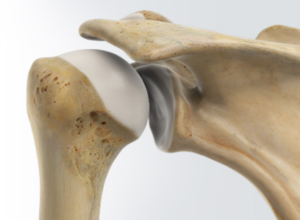Arthroscopic Capsular Plication Animation
Description of Surgery
Shoulder Arthroscopy (Arthroscopic Capsular Plication)
Arthroscopic Capsular Plication is a minimally-invasive surgery used to relieve pain and loss of shoulder stability for patients with loose shoulder. A radiofrequency (RF) probe is inserted into the shoulder to stimulate the tissue capsule that surrounds the shoulder joint. This causes the tissue to contract, tightening the shoulder joint. This arthroscopic procedure is performed at an outpatient surgery center. The patient usually goes home the same day. Several nick incisions are made around the shoulder. The procedure consists of tightening the tissue capsule of the shoulder joint with strategically placed sutures. This serves to stabilize a shoulder that is loose. A sling is worn postoperatively. Physical Therapy is helps to obtain an optimal outcome.
Shoulder Anatomy
Arthroscopic Capsular Plication
 Your shoulder is a complex joint that is capable of more motion than any other joint in your body. It is made up of three bones: your upper arm bone (humerus), your shoulder blade (scapula), and your collarbone (clavicle).
Your shoulder is a complex joint that is capable of more motion than any other joint in your body. It is made up of three bones: your upper arm bone (humerus), your shoulder blade (scapula), and your collarbone (clavicle).
Ball and socket. The head of your upper arm bone fits into a rounded socket in your shoulder blade. This socket is called the glenoid. A slippery tissue called articular cartilage covers the surface of the ball and the socket. It creates a smooth, frictionless surface that helps the bones glide easily across each other.
The glenoid is ringed by strong fibrous cartilage called the labrum. The labrum forms a gasket around the socket, adds stability, and cushions the joint.
Shoulder capsule. The joint is surrounded by bands of tissue called ligaments. They form a capsule that holds the joint together. The undersurface of the capsule is lined by a thin membrane called the synovium. It produces synovial fluid that lubricates the shoulder joint.
Rotator cuff. Four tendons surround the shoulder capsule and help keep your arm bone centered in your shoulder socket. This thick tendon material is called the rotator cuff. The cuff covers the head of the humerus and attaches it to your shoulder blade.
Bursa. There is a lubricating sac called a bursa between the rotator cuff and the bone on top of your shoulder (acromion). The bursa helps the rotator cuff tendons glide smoothly when you move your arm.
Your doctor may recommend shoulder arthroscopy if you have a painful condition that does not respond to nonsurgical treatment. Nonsurgical treatment includes rest, physical therapy, and medications or injections that can reduce inflammation. Inflammation is one of your body’s normal reactions to injury or disease. In an injured or diseased shoulder joint, inflammation causes swelling, pain, and stiffness. Injury, overuse, and age-related wear and tear are responsible for most shoulder problems.
Shoulder arthroscopy may relieve painful symptoms of many problems that damage the rotator cuff tendons, labrum, articular cartilage, and other soft tissues surrounding the joint.
